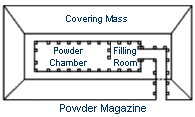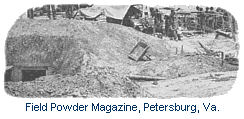 In
its most general sense a magazine is a location where all supplies and material
necessary to sustain an army in field are gathered and stored until transported
to the army or to an intermediate base of operations. In fortifications magazines
more specifically referred to bomb-proof structures where explosive materials,
particularly powder used to serve the artillery armament, were stored. Magazines
in permanent fortifications were usually given one of two basic forms: a
free standing vaulted structure on the parade surrounded by a protective
wall and covered by a thick layer of earth; or a specially venilated casemate
within a rampart or masonry wall. Magazines in field fortifications could
either be constructed as free standing semi-subterranean structures or sunken
under other protective features such as a parapet, barbette platform, or
defilade traverses. Powder magazines were generally designed to include three
main elements: a powder chamber where barrels of powder were stored, a filling
room where shells and cartridge bags were filled, and a turned gallery or
passageway. In
its most general sense a magazine is a location where all supplies and material
necessary to sustain an army in field are gathered and stored until transported
to the army or to an intermediate base of operations. In fortifications magazines
more specifically referred to bomb-proof structures where explosive materials,
particularly powder used to serve the artillery armament, were stored. Magazines
in permanent fortifications were usually given one of two basic forms: a
free standing vaulted structure on the parade surrounded by a protective
wall and covered by a thick layer of earth; or a specially venilated casemate
within a rampart or masonry wall. Magazines in field fortifications could
either be constructed as free standing semi-subterranean structures or sunken
under other protective features such as a parapet, barbette platform, or
defilade traverses. Powder magazines were generally designed to include three
main elements: a powder chamber where barrels of powder were stored, a filling
room where shells and cartridge bags were filled, and a turned gallery or
passageway.
 A
second type of magazine, usually referred to as an expense magazine, was
smaller than a regular powder magazine and positioned near the battery that
it was intended to serve. Expense magazines were designed to hold just enough
cartridge bags and powder to meet the firing requirements of its battery
for one day or less. A
second type of magazine, usually referred to as an expense magazine, was
smaller than a regular powder magazine and positioned near the battery that
it was intended to serve. Expense magazines were designed to hold just enough
cartridge bags and powder to meet the firing requirements of its battery
for one day or less.
|